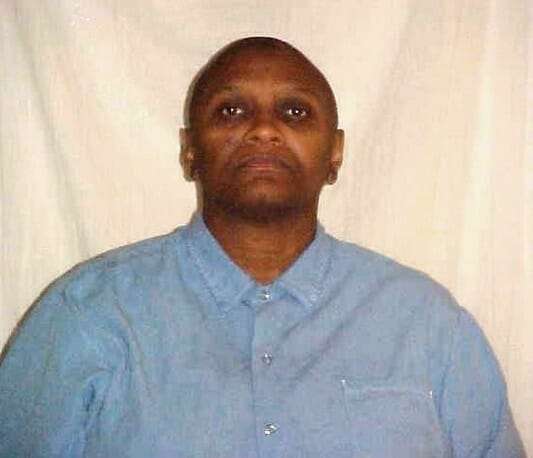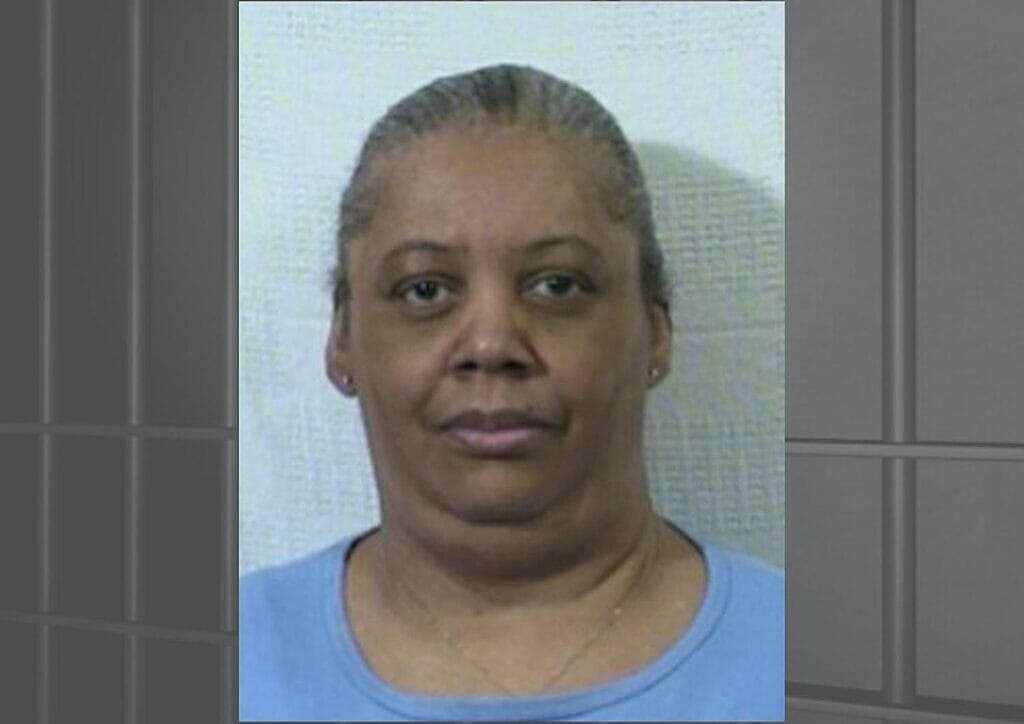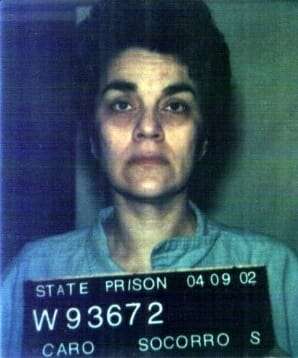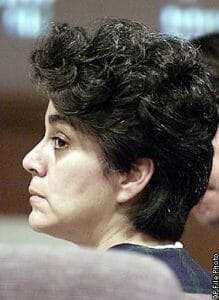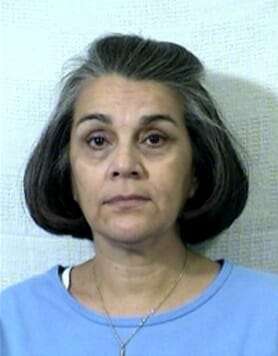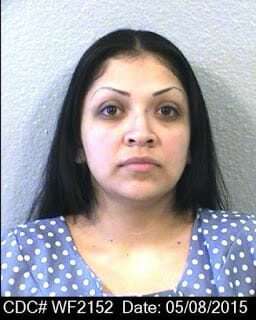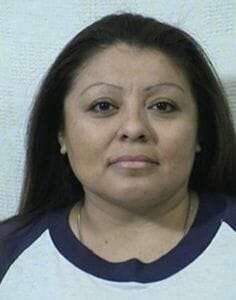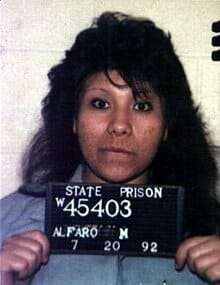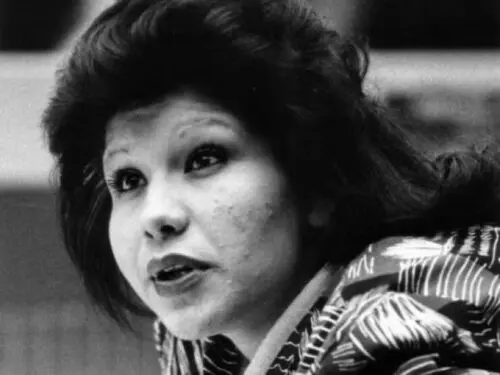
Cynthia Coffman may look like the girl next door however she was convicted on five murders and has spent the last couple of decades on California death row. According to court documents Coffman and her boyfriend James Marlowe would go on a multi state crime spree that would leave bodies in their wake. Coffman did admit to police and eventually the jury that she did murder four people however she insisted that James Marlowe had her under his control leading to these violent actions. Jury did not buy it and Cynthia Coffman was sentenced to death and sent to California Death Row.
Cynthia Coffman 2021 Information
| Inmate Name | COFFMAN, CYNTHIA LYNN |
| CDCR Number | W34001 |
| Age | 57 |
| Admission Date | 10/05/1992 |
| Current Location | Central California Women’s Facility |
| Location Link | Directions |
| Parole Eligible Date (Month/Year) | CONDEMNED |
Cynthia Coffman Other News
On Friday, November 7, 1986, around 5:30 p.m., Corinna Novis cashed a check at a First Interstate Bank drive-through window near the Redlands Mall, after leaving her job at a State Farm Insurance office in Redlands. Novis, who was alone, was driving her new white Honda CRX automobile. Novis had been scheduled for a manicure at a nail salon owned by her friend Terry Davis; she never arrived for the appointment. Novis also had planned to meet friends at a pizza parlor by 7:00 that evening, but she never appeared. That same day, Cynthia Coffman and Marlow went to the Redlands Mall, where Marlow’s sister, Veronica Koppers, worked in a deli restaurant. Between 5:00 and 5:30 p.m., Veronica pointed the couple out to her supervisor as they sat in the mall outside the deli. Cynthia Coffman was wearing a dress; Marlow, a suit and tie.
Later, at the time they had arranged to pick Veronica up from work, Coffman and Marlow entered the deli and handed Veronica her car keys, explaining they had a ride. Around 7:30 p.m., Coffman and Marlow brought Novis to the residence of Richard Drinkhouse. Drinkhouse, who was recovering from injuries sustained in a motorcycle accident and having some difficulty walking, was home alone in the living room watching television when the three arrived. Marlow was wearing dress trousers; Coffman was still wearing a dress; and Novis wore jeans and a black and green top and had a suit jacket draped over her shoulders. Marlow told Drinkhouse they needed to use the bedroom, and the three walked down the hallway. The women entered the bedroom. Marlow returned to the living room and told Drinkhouse they needed to talk to the girl so they could “get her ready teller number” in order to “rob” her bank account. Drinkhouse complained about the intrusion into his house and asked Marlow if he were crazy. Marlow replied in the negative and assured Drinkhouse “there won’t be any witnesses. How is she going to talk to anybody if she’s under a pile of rocks?” Drinkhouse asked Marlow to leave with the women. Marlow declined, saying he was waiting for Veronica to bring some clothing. He told Drinkhouse to stay on the couch and watch television. Knowing Marlow had a gun and having previously observed him fight and beat another man, and also being aware of his own physical disability, Drinkhouse was afraid to leave the house.
At one point, when Drinkhouse appeared to be preparing to leave, he saw Cynthia Coffman, in the hallway, gesture to Marlow, who came out of the bedroom to ask where he was going. Drinkhouse then returned to his seat on the couch in front of the television. Veronica arrived at the Drinkhouse residence 10 to 15 minutes after Coffman, Marlow and Novis. Marlow came out of the bedroom, told Veronica he “had someone [t]here” and cautioned her not to “freak out” on him. Marlow said he needed something from the car; Coffman and Veronica went outside and returned with a brown tote bag.
About 10 minutes later, Coffman drove Veronica to a nearby 7-Eleven store in Novis’s car, leaving Marlow in the bedroom with Novis. Drinkhouse heard Novis ask Marlow if they were going to take her home; Marlow answered, “As soon as they get back.” Veronica testified that, during this period, Coffman did not appear frightened or ask her for help in escaping from Marlow. Drinkhouse likewise testified Coffman appeared to be going along willingly with what Marlow was doing. Upon returning from the 7-Eleven store, Coffman entered the bedroom where Marlow was holding Novis prisoner and remained with them for 10 to 15 minutes.
During this time, Drinkhouse heard the shower running. After the shower was turned off, Marlow emerged from the bedroom wearing pants but no shoes or shirt; he had a towel over his shoulders and appeared to be wet. He walked over to Veronica, said, “We’ve got the number,” and started going through a purse, removing a wallet and identification. Marlow then returned to the bedroom with the purse. Veronica left the house. About five minutes later, Coffman, dressed in jeans, emerged from the bedroom, followed by Novis, handcuffed and with duct tape over her mouth, and Marlow. Novis’s hair appeared to be wet. The three then left the house. Drinkhouse never saw Novis again. Marlow and Coffman returned the following afternoon to ask if Drinkhouse wanted to buy an answering machine or knew anyone who might. When Drinkhouse responded negatively, the two left. Novis’s body was found eight days later, on November 15, in a shallow grave in a vineyard in Fontana. She was missing a fingernail on her left hand, and her shoes and one earring were gone. An earring belonging to Novis was later found in Coffman’s purse.
Forensic pathologist Dr. Gregory Reiber performed an autopsy on November 17. Dr. Reiber concluded that Novis had been killed between five and 10 days previously. Marks on the outside of her neck, injuries to her neck muscles and a fracture of her thyroid cartilage suggested ligature strangulation as the cause of death, but suffocation was another possible cause of death due to the presence of a large amount of soil in the back of her mouth. Marks on her wrists were consistent with handcuffs, and sperm were found in her rectum, although there was no sign of trauma to her anus.
When Novis uncharacteristically failed to appear for work on Monday, November 10, without calling or having given notice of an intended absence, her supervisor, Jean Cramer, went to Novis’s apartment to check on her. Cramer noticed Novis’s car was not parked there, the front door was ajar, and the bedroom was in some disarray. Cramer reported these observations to police, who found no sign of a forced entry. Terry Davis went to Novis’s apartment later that day and determined Novis’s answering machine and typewriter were missing.3 Around 9:30 p.m. on Friday, November 7, the night Novis apparently was killed, Veronica Koppers visited her friend Irene Cardona and tried to sell her an answering machine, later identified as the one taken from Novis’s apartment. Cardona accompanied Veronica, Coffman and Marlow to the house of a friend, who agreed to trade the answering machine for a half-gram of methamphetamine.
The next day, Debra Hawkins bought the answering machine that Cardona had traded. The Redlands Police Department eventually recovered the machine. Harold Brigham, the proprietor of the Sierra Jewelry and Loan in Fontana, testified that on November 8, Coffman pawned a typewriter, using Novis’s identification. Victoria Rotstein, the assistant manager of a Taco Bell on Pacific Coast Highway in Laguna Beach, testified that between 11:00 p.m. and 12:00 a.m. one night in early November 1986, after the restaurant had closed for the evening, a woman came to the locked door and began shaking it. When told the restaurant was closed, the woman started cursing, only to run off when Rotstein said she was going to call the police. Rotstein identified Coffman in a photo lineup and a physical lineup, but did not identify her at trial.
On November 11, 1986, the Taco Bell manager found a bag near a trash receptacle behind the restaurant; inside the bag were Coffman’s and Novis’s drivers’ licenses, Novis’s checks and bank card, and various identification papers belonging to Marlow. The day after Novis’s disappearance, Marlow, Cynthia Coffman and Veronica Koppers returned to Paul Koppers’s home; Marlow asked him if he could get any “cold,” i.e., nontraceable, license plates for the car. On the morning of November 12, Marlow and Coffman returned to Paul Koppers’s residence, where they told him they had been down to “the beach,” “casing out the rich people, looking for somebody to rip off.” Koppers asked Marlow if he knew where Veronica was; after placing two telephone calls, Coffman learned Veronica was in police custody. On the Koppers’ coffee table, Marlow saw a newspaper containing an article about Novis’s disappearance with a photograph of her car. Marlow told Cynthia Coffman they had to get rid of the car.
Paul Koppers refused Marlow’s request to leave some property at his house. Cynthia Coffman and Marlow left the Koppers residence and drove to Big Bear, where they checked into the Bavarian Lodge using a credit card belonging to one Lynell Murray (other evidence showed defendants had killed Murray on November 12). Their subsequent purchases using Murray’s credit card alerted authorities to their whereabouts, and they were arrested on November 14 as they were walking on Big Bear Boulevard, wearing bathing suits despite the cold weather. Cynthia Coffman had a loaded .22-caliber gun in her purse. Novis’s abandoned car was found on a dirt road south of Santa’s Village, about a quarter-mile off Highway 18. Despite Coffman’s efforts to wipe their fingerprints from the car, her prints were found on the license plate, hood and ashtray; a print on the hood of the car was identified as Marlow’s.
A resident of the Big Bear area later found discarded on his property a pair of gray slacks with handcuffs in the pocket, as well as a receipt and clothing from the Alpine Sports Center, where Cynthia Coffman and Marlow had made purchases.
Marlow’s Case Dr. Robert Bucklin, a forensic pathologist, reviewed the autopsy report and related testimony by Dr. Reiber. Based on the lack of anal tearing or other trauma, Dr. Bucklin opined there was insufficient evidence to establish that Novis had suffered anal penetration. He also questioned Dr. Reiber’s conclusion that Novis might have been suffocated, as opposed to aspirating sandy material during the killing or coming into contact with it during the burial process.
Coffman’s Case Cynthia Coffman testified on her own behalf, describing her relationship with Marlow, his threats and violence toward her, and other murders in which, out of fear that he would harm her or her son, she had participated with him while nonetheless lacking any intent to kill. Coffman also presented the testimony of Dr. Lenore Walker, a psychologist and expert on battered woman syndrome, in support of her defense that she lacked the intent to kill. The trial court admitted much of this evidence over Marlow’s objections. Coffman testified she was born in St. Louis, Missouri, in 1962 and, following her graduation from high school, gave birth to a son, Joshua, in August 1980. Shortly thereafter she married Joshua’s father, Ron Coffman, from whom she separated in April 1982. In April 1984, Coffman left St. Louis for Arizona, leaving Joshua in his father’s care, intending to come back for him when she was settled in Arizona. Cynthia Coffman testified that when she met Marlow in April 1986, she was involved in a steady relationship with Doug Huntley. She and Huntley had lived in Page, Arizona, before moving to Barstow, where Huntley took a job in construction. Cynthia Coffman, who previously had worked as a bartender and waitress, was briefly employed in Barstow and also sold methamphetamine.
In April 1986, both Cynthia Coffman and Huntley were arrested after an altercation at a 7-Eleven store in which Coffman pulled a gun on several men who were “hassling” Huntley and “ going to jump him.” Charged with possession of a loaded weapon and methamphetamine, Coffman was released after five days. The day after she was released, Marlow, whom she had never met, showed up at the apartment she shared with Huntley. Marlow said he had been in jail with Huntley and had told him he would check on Coffman to make sure she was all right. Cynthia Coffman and Marlow spent about an hour together on that occasion and smoked some marijuana. After Huntley’s release, he and Cynthia Coffman visited Marlow at the Barstow motel where Marlow was staying.
By June 1986, Huntley was again in custody and Cynthia Coffman was preparing to leave him when Marlow reappeared at her apartment. At Marlow’s request, Coffman drove him to the home of his cousin, Debbie Schwab, in Fontana; while there, he purchased methamphetamine. Within a few days, Coffman moved with Marlow to Newberry Springs, where they stayed with Marlow’s friends Steve and Karen Schmitt. During this period, Marlow told her he was a hit man, a martial arts expert and a White supremacist, and that he had killed Black people in prison. In Newberry Springs, Cynthia Coffman testified, Marlow for the first time tied her up and beat her after accusing her of flirting with another man. During this episode, his demeanor and voice changed; she referred to this persona as Folsom Wolf, after the prison where Marlow had been incarcerated, and over the course of her testimony identified several other occasions when Marlow had seemed to become Wolf and behaved violently toward her. After this initial beating, he apologized, said it would never happen again, and treated her better for a couple of days. She discovered he had taken her address book containing her son’s and parents’ addresses and phone numbers, and he refused to give it back. He became critical of the way she did things and when angry with her would call her names. He refused to let her go anywhere without him, saying that if she ever left him, he would kill her son and family. After some weeks in Newberry Springs, Marlow told Cynthia Coffman his father had died and left him some property in Kentucky and that they would go there. Cynthia Coffman would get her son back, he suggested, and they would live together in Kentucky or else sell everything and move somewhere else. Marlow prevailed on her to steal a friend’s truck for the journey; after having it repainted black, they set off. Not long before they left, Marlow bit her fingernails down to the quick.
They went by way of Colorado, where they stayed with a former supervisor of Marlow’s, Gene Kelly, who discussed the possibility of Marlow’s working for him again in Georgia. They then passed through St. Louis. Arriving in the evening and reaching her parents by telephone at midnight, Cynthia Coffman was told it was too late for her to visit that night; the next morning, Marlow told her there was no time for her to see her son. Accordingly, although Cynthia Coffman had not seen her son since Christmas 1984, they drove straight to Kentucky. On arriving, they stayed with Marlow’s friend Greg (“Lardo”) Lyons and his wife Linda in the town of Pine Knot. Marlow informed Cynthia Coffman the real reason for the trip was to carry out a contract killing on a “snitch.” Once they had located the intended victim’s house, Marlow told her she was to do the killing. She protested, but ultimately did as he directed, carrying a gun, fashioning her bandana into a halter top, and luring the victim out of his house on the pretext of needing help with her car. When the victim, who had a gun tucked into his belt, had come to the spot where their truck was parked and was taking a look under the hood, Marlow appeared and demanded to know what the man was doing with his sister. Marlow then grabbed the man’s gun. Cynthia Coffman testified she heard a shot go off, but did not see what happened. Cynthia Coffman and Marlow returned to Lyons’s home. Sometime later, Marlow and Lyons left the house and returned with a wad of money. Cynthia Coffman counted it: there was $5,000. Coffman testified that Marlow subjected her to several severe beatings in Kentucky. In mid-August 1986, they drove to Atlanta, where Marlow told her he had a job. While in a bar after his fourth day working for Gene Kelly, Marlow became angry at Cynthia Coffman. That night, in their hotel room, he began beating her, took a pair of scissors, threatened to cut her eye out, and then cut off all her hair. He forced her out of the motel room without her clothes, let her back in and forcibly sodomized her.
Marlow failed to show up for work the next day and was fired. They then returned to Kentucky, where they unsuccessfully attempted a burglary and spent time going on “pot hunts,” i.e., searching rural areas for marijuana plants to steal. Just before they left Kentucky to go to Arizona, they stole a station wagon. Back in Arizona, they burglarized Doug Huntley’s parents’ house and stole a safe. After opening it to find only some papers and 10 silver dollars, they took the coins and buried the safe in the desert. Returning to Newberry Springs and again briefly staying with the Schmitts, they sold the stolen car and stole two rings belonging to their hosts, pawning one and trading the other for methamphetamine. From Newberry Springs, in early October 1986, Marlow and Cynthia Coffman took a bus to Fontana, where they again stayed with Marlow’s cousins, the Schwabs. During that visit, Marlow tattooed Coffman’s buttocks with the words “Property of Folsom Wolf” and her ring finger with the letters “W-O-L-F” and lightning bolts, telling her it was a wedding ring. Leaving the Schwab residence in late October, they hitchhiked to the house of Rita Robbeloth and her son Curtis, who were friends of Marlow’s sister, Veronica. From there, Veronica brought Cynthia Coffman and Marlow to the home she shared with her husband, Paul, and his brother, Steve.
At the Robbeloth residence one day, Cynthia Coffman, Marlow and Veronica were sharing some methamphetamine, and Marlow became enraged over Coffman’s request for an equal share. Although Cynthia Coffman quickly backed down, Marlow began punching her and threatened to leave her by the side of the road. Later, back at the Koppers residence, Marlow continued to beat, kick and threaten to kill her, forced her to consume four pills he told her were cyanide, extinguished a cigarette on her face and stabbed her in the leg, rendering her unconscious for a day and unable to walk for two days. Cynthia Coffman recounted how she and Marlow, along with Veronica, left the Koppers residence and came to stay at the Drinkhouse residence the night before they abducted Novis.
On the morning of November 7, 1986, Marlow told her to put on a dress, saying they would not be able to rob anyone if they were not dressed nicely. Marlow borrowed a suit from Curtis Robbeloth and told Cynthia Coffman they had to “get a girl.” She testified she did not understand he intended to kill the girl. After dropping Veronica off at her job, Coffman and Marlow drove around in Veronica’s car looking for someone to rob. Eventually they parked in front of the Redlands Mall. When they saw Novis’s white car pull up in front of them and Novis enter the mall, Marlow said, “That is the one we are going to get,” despite Coffman’s protests that the girl was too young to have money. He directed Coffman to get out of the car and ask Novis for a ride when the latter returned to her car. Cynthia Coffman complied, asking Novis if she could give them a ride to the University of Redlands. When Novis agreed, Marlow got in the two-seater car with Coffman on his lap. As Novis drove, Marlow took the gun from Coffman, displayed it and told Novis to pull over. Then Coffman drove while Novis, handcuffed, sat on Marlow’s lap. He told Novis they were going to a friend’s house and directed Cynthia Coffman to the Drinkhouse residence, where they arrived between 7:00 and 7:30 p.m. When Novis told them she had something to do that evening, Marlow assured her, “Oh, you’ll make it where you are going. Don’t worry.” As Marlow went in and out of the bedroom at the Drinkhouse residence, Coffman sat with Novis. When Novis asked if she was going to be allowed to leave, Cynthia Coffman told her to do what Marlow said and he would let her go. Showing Novis the stab wound on her leg, Coffman told her Marlow was “just crazy.” Marlow dispatched Coffman to make coffee and proceeded to try to get Novis to disclose her personal identification number (PIN).
Finally Novis gave him a number. Marlow then taped Novis’s mouth and said, “We are going to take a shower.” He removed Novis’s clothes and put her, still handcuffed, into the shower. Cynthia Coffman testified he told her (Coffman) to get into the shower, but she refused. Thinking Marlow was going to rape Novis, Cynthia Coffman testified she “turned around” and “walked away” into the living room. There she retrieved her jeans and returned to the bedroom to get dressed. Cynthia Coffman denied either arousing Marlow sexually or having anything to do with anything that happened in the shower. When Marlow told her to dress Novis, Cynthia Coffman responded that if he uncuffed her, she could do so herself. He removed the handcuffs to permit Novis to dress, then handcuffed her again to a bedpost.
Around this time, Veronica arrived at the Drinkhouse residence. Marlow took Novis’s purse, directed Veronica to get his bag out of her car, and told Cynthia Coffman and his sister to go to the store, where they bought sodas and cigarettes. Back at the Drinkhouse residence, Veronica departed and, soon thereafter, Marlow, Coffman and Novis left, with Coffman driving and Novis, duct tape on her mouth, handcuffed, and covered with blankets, in the back of the car. Marlow told Coffman to drive to their drug connection in Fontana, but directed her into a vineyard. There, Marlow and Novis got out of the car, and he removed her handcuffs and tape. He explained they could not bring a stranger to the drug connection’s house, so he would wait there with Novis while Cynthia Coffman scored the dope. They walked off, with Marlow carrying a blanket and a bag containing a shovel.
Cynthia Coffman testified she felt confused at that point because she possessed only $15, insufficient funds for a drug purchase. Believing Marlow intended to rape Novis, she backed the car out of the vineyard, parked down the street and smoked a cigarette. When she returned, no one was there. She could hear the sound of digging. Some 10 to 15 minutes later Marlow reappeared, alone. Without speaking, he threw some items into the back of the car and, after Cynthia Coffman had driven for a while, began to hit her and berated her for driving away. They returned to the Robbeloth residence, where Marlow changed clothes.
Next they drove to a First Interstate Bank branch, but were unable to access Novis’s account because she had given them the wrong PIN. From there, around 9:30 p.m., they went to Novis’s apartment and, after a search, found a card on which Novis had written her PIN. They also took a typewriter, a telephone answering machine and a small amount of cash. They returned to the Robbeloth residence, where Marlow spoke with Veronica, who then drove them around unsuccessfully looking for a friend to buy the answering machine.
Leaving Veronica around 3:00 or 4:00 a.m., Cynthia Coffman and Marlow tried again to access Novis’s account, only to learn there was not enough money in the account to enable them to withdraw funds using the automated teller. They returned to the Drinkhouse residence.
The next morning, Veronica joined them around 8:00 or 9:00. After trying again to sell the answering machine, they pawned the typewriter for $50 and bought some methamphetamine. That afternoon Cynthia Coffman and Marlow went to Lytle Creek to dispose of Novis’s belongings. Cynthia Coffman had not asked Marlow what had happened to Novis; she testified she did not want to know and thought he had left her tied up in the vineyard. They returned to the Drinkhouse residence around 5:00 p.m.
Later that evening, after trading the answering machine for some methamphetamine in the transaction described in Irene Cardona’s testimony, Coffman and Marlow went with Veronica to the Koppers residence, where they “did some speed” and developed a plan to go to the beach in Orange County on Marlow’s theory that “it would be easier to get money down there because all rich people live down at the beach.” Veronica drove Coffman and Marlow back to Novis’s car, which they drove to Huntington Beach, arriving at sunrise. After lying on the beach for several hours, they looked unsuccessfully for people to rob. Marlow berated Cynthia Coffman for their inability to find a victim, held a gun to her head and ordered her to drive. After threatening to shoot her, he began to punch the stab wound on her leg. That night, they slept in the car in front of some houses near the beach. The next day, Coffman cashed a check on Novis’s account, receiving $15. They continued their search for a potential victim and eventually bought dinner at a Taco Bell, where Marlow discarded their identification, along with Novis’s. They drove up into the hills and spent the night.
The next day, they resumed their search for someone to rob. Seeing a woman walking out of Prime Cleaners, Marlow commented that she would be a good one to rob. They continued to drive around, however, and spent the night in the car behind a motel on Pacific Coast Highway after removing the license plates from another car and putting them on Novis’s car. The following afternoon, Cynthia Coffman and Marlow entered Prime Cleaners and committed the robbery, kidnapping, rape and murder of Lynell Murray detailed below (see post, 34 Cal.4th at pp. 32-34, 17 Cal.Rptr.3d at pp. 744-746, 96 P.3d at pp. 59-60).
Cynthia Coffman also presented the testimony of several witnesses suggesting her normally outgoing personality underwent a change and that she behaved submissively and fearfully after she became Marlow’s girlfriend. Judy Scott, Coffman’s friend from Page, Arizona, testified that when Coffman and Marlow visited her in October 1986, Coffman, who previously had been talkative and concerned about the appearance of her hair, avoided eye contact with Scott, spoke tersely and had extremely short hair that she kept covered with a bandana. Lucille Watters testified that during the couple’s July 1986 visit to her house, Cynthia Coffman appeared nervous, rubbing her hands and shaking. Linda Genoe, Lyons’s ex-wife, testified she met Cynthia Coffman in June 1986 when she and Marlow visited her at her home in Kentucky. Genoe observed that whenever Marlow wanted something, he would clap, call “Cynful” and tell her what to do. Cynthia Coffman would always sit at his feet. On one occasion, Genoe saw Cynthia Coffman lying on the floor of the bedroom in which she was staying, naked and crying; Coffman did not respond when Genoe asked what was wrong.
The next morning, Genoe saw scratches on Coffman’s face and bruises around her neck, and Coffman seemed afraid to talk about it. Once Genoe observed Cynthia Coffman cleaning between the spokes on Marlow’s motorcycle with a toothbrush while Marlow watched. While at Genoe’s house, Coffman and Marlow got “married” in a “ biker’s wedding.” Coffman also presented the testimony of Psychologist Lenore Walker, Ph.D., an expert in battered woman syndrome. Dr. Walker opined that Coffman was generally credible and suffered from battered woman syndrome, which she described as a collection of symptoms that is a subcategory of posttraumatic stress disorder. Certain features of defendants’ relationship fit the profile of a battering relationship: a pattern of escalating violence, sexual abuse within the relationship, jealousy, psychological torture, threats to kill, Cynthia Coffman’s awareness of Marlow’s acts of violence toward others, and Marlow’s alcohol and drug abuse.
Dr. Walker administered the Minnesota Multiphasic Personality Inventory to Cynthia Coffman and diagnosed her as having posttraumatic stress disorder and depression with dysthymia, a depressed mood deriving from early childhood. Officer Lisa Baker of the Redlands Police Department testified that on November 15, 1986, she took Cynthia Coffman to the San Bernardino County Medical Center and there observed various scratches and bruises on her arms and legs, a bite mark on her wrist, and a partly healed inch-long cut on her leg. Coffman told Baker the bruises and scratches came from climbing rocks in Big Bear. Gene Kelly, formerly Marlow’s supervisor in his employment with a company that erected microwave towers, testified that one evening in June 1986 he saw Marlow, who believed Cynthia Coffman had been flirting with another man, yank her out of a restaurant door by her hair.
Frequently Asked Questions
Cynthia Coffman Photos
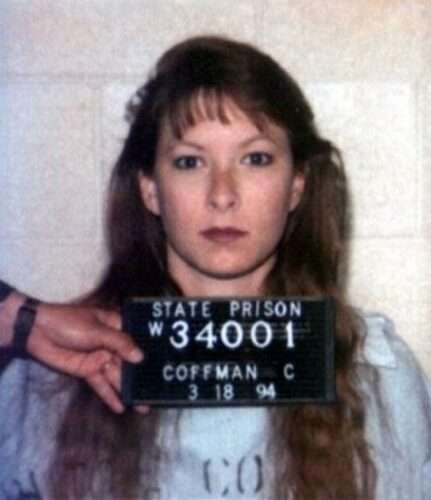
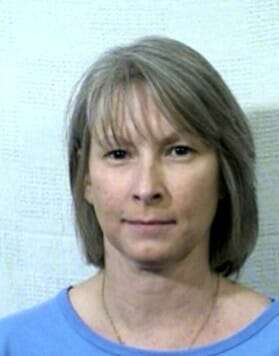
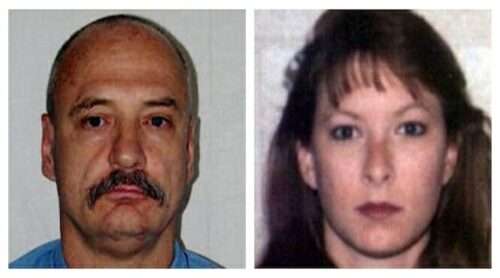
Cynthia Coffman FAQ
Cynthia Coffman 2021
Cynthia Coffman is currently incarcerated at the Central California Women’s Facility which is California Death Row for Women
Why Is Cynthia Coffman On Death Row
Cynthia Coffman was convicted fo four murders



